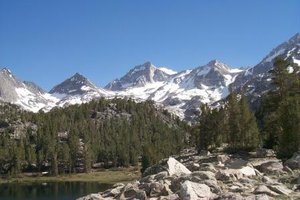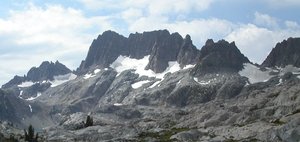Sierra Nevada (US)
|
|
The Sierra Nevada is a mountain range that is mostly in eastern California. The range is also known as The Sierra or The Sierras.
| Contents |
Geography
The Sierra Nevada stretches 400 miles (650 km), from Fredonyer Pass in the north to Tehachapi Pass in the south. It is bounded on the west by California's Central Valley, and on the east by the Great Basin.
In west-east cross section, the Sierra is shaped like a non-equilateral triangle: the altitude gradually increases as you travel east, until you reach the crest, whereupon the altitude rapidly decreases, forming a steep escarpment. Thus, the crest runs principally along the eastern edge of the Sierra Nevada range. Rivers flowing west from the Sierra crest eventually drain into the Pacific Ocean, while rivers draining east flow into the Great Basin and do not reach any ocean. However, water from several streams and the Owens River is redirected to the city of Los Angeles (see Los Angeles Aqueduct). Thus, some east-flowing river water does make it to the Pacific Ocean.
There are several notable geographical features in the Sierra Nevada:
- Lake Tahoe is a large, clear freshwater lake in the northern Sierra Nevada, with an elevation of 6225 feet (1,897 m) and an area of 191 square miles (489 km²). Lake Tahoe lies between the main Sierra and the Carson Range, a spur of the Sierra.
- Hetch Hetchy Valley, Yosemite Valley, and Kings Canyon are beautiful, glacially-scoured canyons on the west side of the Sierra.
- Yosemite National Park is filled with stunning features, such as waterfalls and granite domes.
- Mount Whitney, at 14,505 feet (4,421 m), is the highest point in the continental United States.
- Groves of Giant Sequoias occur along a narrow band of altitude on the western side of the Sierra Nevada. Giant Sequoias are the most massive trees in the world.
The height of the mountains in the Sierra Nevada gradually increases from north to south. Thus, the crest near Lake Tahoe is roughly 9000 ft (2,700 m) high, the crest near Yosemite National Park is roughly 13000 ft (4,000 m) high, and the entire range attains its peak at Mount Whitney. South of Mount Whitney, the range quickly diminishes in elevation.
Geology
Sierra_Nevada_near_Bridgeport,_California-1000px.jpeg
See Geology of the Yosemite area for a detailed article about the geology of the central Sierra Nevada.
The geological history of the Sierra Nevada begins in the Jurassic period, approximately 150 million years ago. At that time, an island arc collided with the West coast of North America and raised a set of mountains, in an event called the Nevadan orogeny. This event produced metamorphic rock. At roughly the same time, a subduction zone started to form at the edge of the continent. This means that an oceanic plate started to dive beneath the North American plate. Magma from the melting oceanic plate rose and created plutons of solid granite, deep below the surface. These plutons formed at various times, from 115 million to 87 million years ago. By 65 million years ago, the proto-Sierra Nevada was worn down to a range of rolling low mountains, a few thousand feet high.
About 25 million years ago, the Sierra Nevada started to rise and tilt to the west. Rivers started cutting deep canyons on both sides of the range. The Earth's climate cooled, and ice ages started about 2.5 million years ago. Glaciers carved out characteristic U-shaped canyons throughout the Sierra. The combination of river and glacier erosion exposed the granitic plutons previously buried, leaving only a remnant of metamorphic rock on top of some Sierra peaks.
Uplift of the Sierra Nevada continues today, especially along its eastern side. This uplift causes large earthquakes, such as the Lone Pine earthquake of 1872.
Biology
Upper_montane_veg_zone_in_Yosemite.jpg
Main article: Biology of the Sierra Nevada
The Sierra Nevada are divided into a number of biotic zones:
- The Pinyon pine-Juniper woodland, 5000-7000 ft (1500-2100 m) east side only
- Notable species: Pinyon Jay, Desert Bighorn Sheep
- The lower montane forest, 3000-7000 ft (1000-2100 m) west side, 7000-8500 ft (2100-2600 m) east side
- Notable species: Ponderosa pine and Jeffrey pine, California black oak, Incense-cedar, Giant Sequoia, Dark-eyed Junco, Mountain chickadee, Western gray squirrel, Mule deer, American black bear
- The upper montane forest, 7000-9000 ft (2100-2700 m) west side, 8500-10500 ft (2600-3100 m) east side
- Notable species: Lodgepole pine, Red Fir, Mountain Hemlock, Sierra Juniper, Hermit Thrush, Sage Grouse, Great Grey Owl, Golden-mantled Ground Squirrel, Marten
- The subalpine forest, 9000-10500 ft (2700-3100 m) west side, 10500-11500 ft (3100-3500 m) east side
- Notable species: Whitebark pine and Foxtail pine, Clark's Nutcracker
- The alpine region >10500 ft (>3100 m) west side, >11500 ft (>3500 m) east side
- Notable species: Sky Pilot, Pika, Belding's ground squirrel, Yellow-bellied marmot, California Bighorn Sheep
History
History of Exploration
The earliest identified inhabitants of the Sierra Nevada were the Paiute tribe on the east side and the Miwok tribe on the west. These tribes traded goods by meeting at and traveling over mountain passes. Even today, passes such as Duck Pass are littered with discarded obsidian arrowheads, which are remnants of the trading.
In the winter of 1844, Lieutenant John C. Frémont, accompanied by Kit Carson, was the first white man to see Lake Tahoe.
Red-Slate-Mountain.web.jpg
By 1860, even though the California gold rush populated the flanks of the Sierra Nevada, most of the Sierra remained unexplored. Therefore, the state legislature authorized the California Geological Survey to officially explore the Sierra (and survey the rest of the state). Josiah Whitney was appointed to head the survey.
Men of the survey, including William H. Brewer, Charles Hoffmann, and Clarence King, explored the backcountry of what would become Yosemite National Park in 1863. In 1864, they explored the area around Kings Canyon. King later recounted his adventures over the Kings-Kern divide in his book Mountaineering in the Sierra Nevada. In 1871, King mistakenly thought that Mount Langley was the highest peak in the Sierra and climbed it. However, before he could climb the true highest peak (Mount Whitney), fishermen from Lone Pine, California climbed it and left a note.
Between 1892 and 1897, Theodore Solomons was the first explorer to attempt to map a route along the crest of the Sierra (what would eventually become the John Muir Trail, along a different route). On his 1894 expedition, he took along Leigh Bierce, son of writer Ambrose Bierce.
Other noted early mountaineers included:
- John Muir
- Bolton Coit Brown
- Joseph LeConte
- James S. Hutchinson
- Norman Clyde
- Walter Starr, Sr.
- Walter A. Starr, Jr.
Features in the Sierra are named after these men.
History of the Name
Sierra Nevada means "snowy range" in Spanish. In April of 1776, Padre Pedro Font on the second de Anza expedition gave that name to the mountains that could be seen in the distance to the east. Its most common nickname is the Range of Light. This nickname comes from John Muir, who in 1894 wrote in The Mountains of California:
- Looking eastward from the summit of Pacheco Pass one shining morning, a landscape was displayed that after all my wanderings still appears as the most beautiful I have ever beheld. At my feet lay the Great Central Valley of California, level and flowery, like a lake of pure sunshine, forty or fifty miles wide, five hundred miles long, one rich furred garden of yellow Compositae. And from the eastern boundary of this vast golden flower-bed rose the mighty Sierra, miles in height, and so gloriously colored and so radiant, it seemed not clothed with light but wholly composed of it, like the wall of some celestial city.... Then it seemed to me that the Sierra should be called, not the Nevada or Snowy Range, but the Range of Light. And after ten years of wandering and wondering in the heart of it, rejoicing in its glorious floods of light, the white beams of the morning streaming through the passes, the noonday radiance on the crystal rocks, the flush of the alpenglow, and the irised spray of countless waterfalls, it still seems above all others the Range of Light.
This description is due to the unusually light colored granite exposed by glacial action.
Interesting facts
A unique peculiarity of the Sierra Nevada is that, under certain wind conditions, a large circular tube of air begins to roll on the southeast side. This is known as the "Sierra Nevada Rotor." This "mountain wave" forms when dry continental winds from the east cause the formation of a stacked set of counter-revolving cylinders of air reaching into the stratosphere. As of 2004, no sailplane has found its top. Similar features occur on many mountain ranges, but it is often observed and utilized in the Sierra. All recent world altitude records set in unpowered aircraft were set in the Sierra Nevada Rotor, most flown from Mojave Airport.
The Sierra Nevada casts the valleys east of the Sierra in a rain shadow, which makes Death Valley and Owens Valley "the land of little rain".
See also
- List of Sierra Nevada topics, including lists of mountains, rivers, parks, and other natural features.
- List of guidebooks about the Sierra Nevada
External links
- List of Sierra Peaks at climber.org (http://www.climber.org/data/SierraPeaks.html)
- The Mountains of California (http://www.sierraclub.org/john_muir_exhibit/writings/the_mountains_of_california)
- Geological Time Line for the Sierra Nevada, National Park Service (http://www.nps.gov/yose/education/pdfs/Geo_timeline.pdf)
References
- A Natural History of California, Allan A. Schoenherr, UC Press, ISBN 0520069226
- Sierra High Route: Traversing Timberline Country, Steve Roper, The Mountaineers Press, ISBN 0898865069, (1997).
de:Sierra Nevada (USA)
et:Sierra Nevada (USA)
id:Sierra Nevada (AS)
ja:シエラネヴァダ山脈 (アメリカ)
nl:Sierra Nevada (VS)




